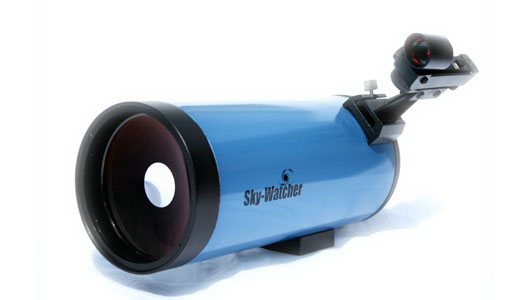Sky-Watcher SkyMax 102T
Magnifications (with eyepieces supplied): x52 & x130
Highest Practical Power (Potential): x204
Diameter of Primary Mirror: 102mm
Telescope Focal Length: 1300mm (f/12.74)
Eyepieces Supplied (1.25"): 10mm & 25mm
Red Dot Finder
90º Diagonal
28% more Light Gathering than 90mm
The skywatchers sky, max 102 Maksutov-Cassegrain telescope is typical of most people's idea of a small grab and go instrument. Like the vixen is also ideal for planetary work, and with its large aperture opens up the sky quite nicely. The downside is that this type of telescope is a lack of contrast, compared to refractor and a larger sizes, they can get quite heavy. A full review will appear shortly elsewhere on this website.
Catadioptrics use a combination of mirrors and lenses to fold the optics
and form the image. There are two popular designs: the Schmidt-Cassegrain
and the Maksutov-Cassegrain. In the Schmidt-Cassegrain the light enters
through a thin aspheric Schmidt correcting lens, it then strikes the spherical
primary mirror which reflects the light out an opening in the rear of the
instrument where the image is formed at the eyepiece.
Catadioptrics are
the most popular type of instrument, with the most modern design, marketed
throughout the world in 3.5" and larger apertures.
Advantages
- Best all-round, all-purpose telescope design. Combines the optical advantages of both lenses and mirrors while canceling their disadvantages.
- Excellent optics with razor sharp images over a wide field.
- Excellent for deep sky observing or astrophotography with fast films.
- Very good for lunar, planetary and binary star observing or photography.
- Excellent for terrestrial viewing or photography.
- Focal ratio generally around f/10. Useful for all types of photography. Avoid faster f/ratio telescopes (they yield lower contrast and increase aberrations). For faster astrophotography, use a Reducer/Corrector lens.
- Closed tube design reduces image degrading air currents.
- Extremely compact and portable.
- Easy to use.
- Durable and virtually maintenance free.
- Large apertures at reasonable prices and less expensive than equivalent aperture reflectors.
- Most versatile type of telescope.
- More accessories available than with other types of telescope.
- Best near focus capability of any type of telescope.
Disadvantages
- More expensive than Newtonians of equal aperture.
- Slight light loss due to secondary mirror obstruction compared to refractors
- Requires Focal Reducer for astrophotography
- Possible long cool-down time
Maksutov-Cassegrain
The Maksutov-Cassegrain design is similar to the Schmidt with basically
the same advantages and disadvantages but is not quite as good optically
given the same focal ratios. It uses a thick meniscus correcting lens
with a heavy curvature and a secondary mirror that is usually an aluminized
spot on the corrector.
The Maksutov is heavier than the Schmidt and because of the thick correcting
lens takes a long time to reach thermal stability at night in larger apertures
(over 90mm). At 150mm it's not that portable.
The Maksutov optical design typically is easier to make and should be less
expensive than the Schmidt-Cassegrain.
In summary For
planetary and starting astrophotography then these are still excellent. Their long focal lengths require some adaptation fro decent astrophotography and are not so good for deep sky visual work below 8" diameter.
If you wish for the ultimate planetary telescope, and also a scope which is virtually
maintenance free then look no further than a refractor or a Catadioptric.



